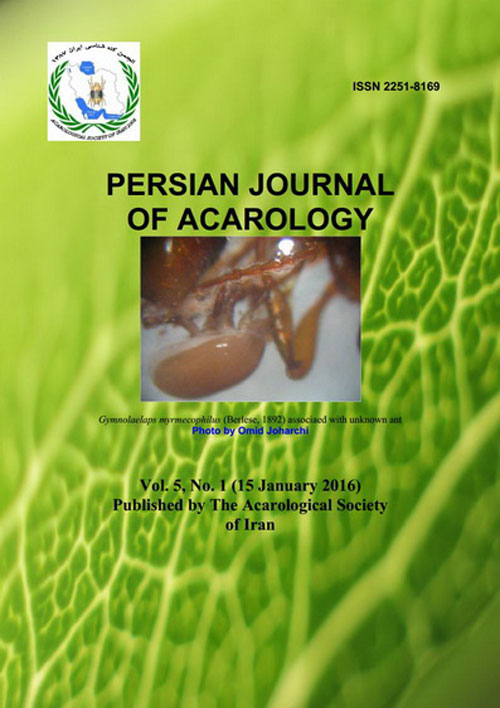فهرست مطالب

Persian Journal of Acarology
Volume:5 Issue: 1, Winter 2016
- تاریخ انتشار: 1394/12/12
- تعداد عناوین: 9
-
-
Page 1A new species of Cunaxoides, C. shahriari Bagheri, Paktinat-Saeij and Castro sp. nov., is described from soil, humus and moss from northern Iran. A key to the Cunaxoides species of the Iran is also provided.Keywords: Prostigmata, Cunaxoidinae, predatory mites, systematics
-
Page 9Hypochthoniella minutissima (Berlese, 1904) is newly reported from Guilan Province Iran. After comparison with the original description and redescriptions, we here provide an expanded description, including illustrations for the adult, based on the material collected from Guilan Province Iran. A checklist and an identification key to the twenty species of arthronotic oribatid mites of Guilan Province are provided. The genus and subgenus Eohypochthonius (Eohypochthonius) Jacot, and Eohypochthonius (Eohypochthonius) magnus Aoki, E. (E.) crassisetiger Aoki, Cosmochthonius (Cosmochthonius) plumatus Berlese, Brachychthonius impressus Moritz and B. hungaricus (Balogh) are new records for Iran mite fauna.Keywords: Iran, Guilan, Oribatid mites, Enarthronota, new record, redescription
-
Page 27Laelaspis natanziensis sp. nov., a new laelapid mite (Acari: Mesostigmata) is described and illustrated based on females and male collected in the nest of Tetramorium sp. (Hymenoptera: Formicidae) in Natanz region, Isfahan Province, Iran.Keywords: Acari, Taxonomy, Mesostigmata, Laelaspis, ants, Iran
-
Page 35Three eriophyoid mites (two new genera and three new combinations) from Thailand are redescribed herein. They are: Phutsona gen. nov., Ph. ervatamiae (Chandrapatya, 1991) comb. nov. on Gardenia jasminoides J. Ellis (Rubiaceae) [the original host plant, Ervatamia coronaria, was an error in identification]; Lipacarus gen. nov., L. eugeniae (Boczek, 1992) comb. nov. on Syzygium samarangense (Blume) Merr. and L.M. Perry (Myrtaceae); Pentacecidophyes litchi (Boczek, 1996) comb. nov. on Litchi chinensis Sonn. (Sapindaceae). Pentacecidophyes is reassigned to Eriophyidae, Phyllocoptinae, Phyllocoptini. Pentacecidophyes xinglongis Xue, Cheng and Hong, 2011 is considered as a junior synonym of Pe. litchi.Keywords: Eriophyidae, Diptilomiopidae, Phutsona gen. nov., Lipacarus gen. nov., Pentacecidophyes, ɑ, taxonomy
-
Page 51Rodent's significant role in transmission of serious zoonotic diseases is considered as an interesting subject in public attention. With respect to the importance of arthropod-infested rodents in zoonotic diseases transmission and extent distribution of Mus musculus, the present study aimed to analyze the interrelationship between host's sex and age of M. musculus with the ectoparasites prevalence in Mashhad and vicinity, northeast of Iran. Mites, ticks and lice were cleared in Nesbit and fleas were made transparent by 10% KOH and then individually mounted in Hoyer's medium. They were identified with the aid of valid identification keys. A total of 267 ectoparsites belonging to eight species were collected from 93 hosts (48.38% male vs. 51.62% female). Among parasite groups, mites, ticks, lice and fleas occurred in prevalence of 46.06%, 22.84%, 16.85% and 14.23%, respectively. Our results demonstrated significant higher ectopara-site burden on male hosts for Haemolaelaps sp., Nosopsyllus fasciatus, Ctenophtalmus sp. and Laelaps algericus. However, two tick species of Haemaphysalis punctata and Haemophysalis sp. showed a tendency of higher prevalence in females and no significant difference in the prevalence of lice species of Hoplopleura captiosa were observed between the host sexes. Similarly, no significant differences in ectoparasite infestations were observed between the age categories.Keywords: Ectoparasite, infestation, gender, maturity, prevalence, rode
-
Page 63The prey preference of polyphagous predators plays an important role in suppressing different species of herbivorous mites and insects. Prey stages preference of the predatory mite, Amblyseius swirskii Athias-Henriot was investigated among egg, protonymph and deutonymph of Tetranychus urticae Koch and egg, first and second instar nymphs of Bemisia tabaci Gennadius. All experiments were conducted using bean (cultivar: Almoti) leaf discs in Petri dishes (8 cm in diameter) under laboratory condition with 25±2 ̊C, 70±5% RH and 16 L: 8 D photoperiod. The preference for female predator was calculated with Manlys preference index (β). Comparison of the preference indices using a t-test showed that A. swirskii consumed significantly more eggs than protonymphs and deutonymphs of T. urticae. There was also a significant difference between consumed protonymphs and deutonymphs of T. urticae. A. swirskii consumed significantly more eggs than second instar nymphs of B. tabaci. There was a significant difference between first instar nymphs and second instar nymphs of B. tabaci and between eggs and first instar nymphs of B. tabaci. Our findings suggest that prey stages had effect on the prey selection of A. swirskii.Keywords: Biological control, predator, prey stage, spider mite, whitefly
-
Page 71Rice sheath mite, Steneotarsonemus spinki Smiley (Acari: Tarsonemidae), was observed to pose a serious threat to the rice cultivation under Bengal Basin of West Bengal, India during wet season. The mite appeared during tillering to panicle emergence with a maximum population encountered during early ripening stage of the crop causing characteristic brownish specks on the leaf sheath and on the grains resulting poor yield particularly in case of susceptible rice cultivars, IET-4786, IR-36, IET-4094 and many others high yielding varieties. Acaricides was found to be inadequate in suppressing the mite population. The result of the experiment reveals that the mite population significantly varied among different treatments with a maximum mite population colonized (929.67 mite/ leaf sheath) in chemical fertilized plots and a minimum recorded (108.33 mite/leaf sheath) in leaf manure of Glyricidia maculata (Kunth) Walp treated plots. However, maximum seed yield (fresh rough grain) was obtained from combined application of mustard cake, Glyricidia leaf manure and chemical fertilizers. (9.16 t/ha) which was at par with that of chemical fertilizer treated plots and the minimum yield was recorded from control plots (6.18 t/ha).Keywords: Rice, Steneotarsonemus spinki, organic, inorganic nutrients, management

